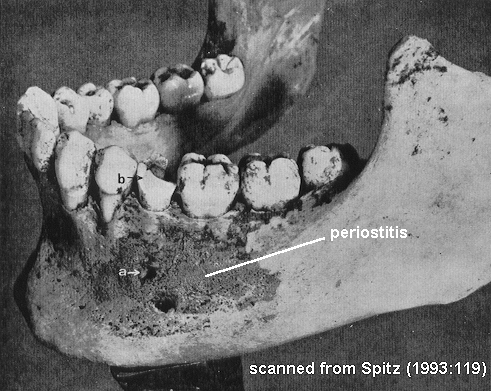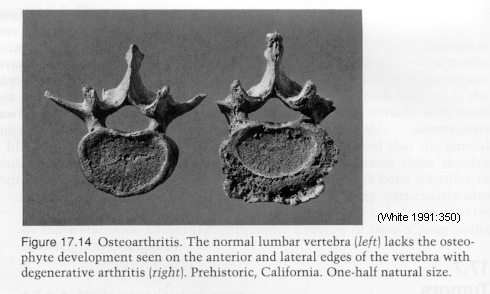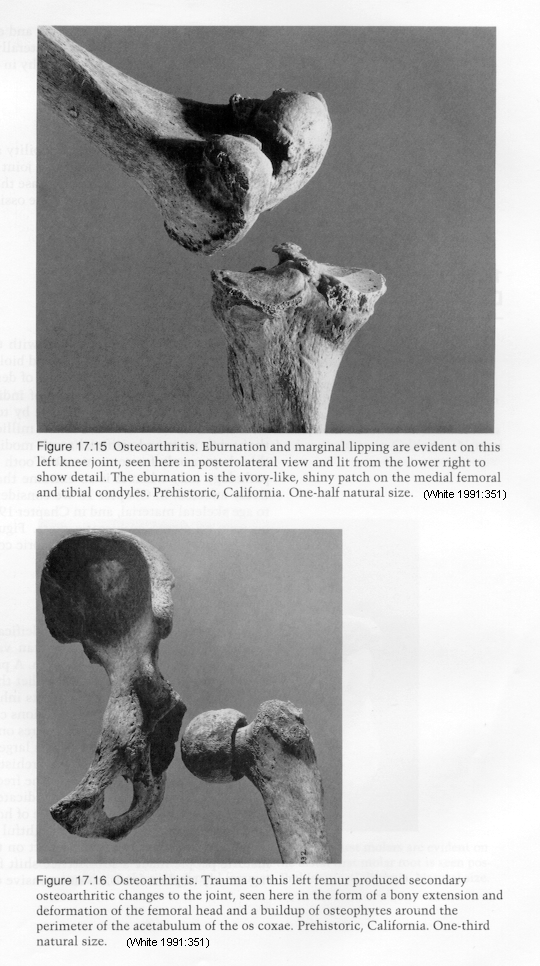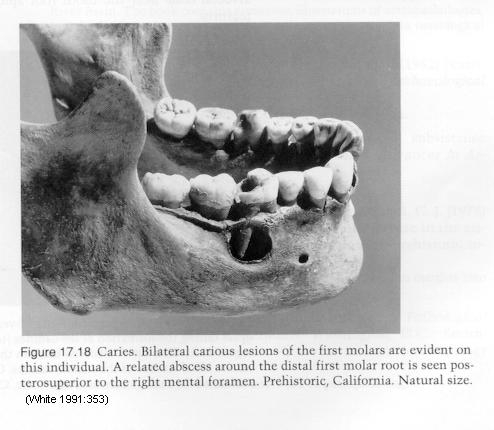

INTRODUCTION
The analytical stage of forensic anthropology involves answering questions that lead to identification of the individual whose remains are being examined. The questions asked in developing a biological or demographic profile for an individual include the following:
OBJECTIVES
READINGS
TERMS
GENERAL INSTRUCTIONS
SKELETAL PATHOLOGIES
Skeletal pathologies are diseases that affect the growth of bone due to microbial infection, metabolic or nutrient deficiencies, hematological disorders, repetitive activity, injuries, or congenital conditions.
Pathologies resulting from infections include periostitis (periosteal reaction), osteomyletis (osteitis), treponemal diseases like syphilis, tuberculosis, and leprosy. Scurvy, rickets, and gout are metabolic or nutrient deficiencies that affect bone. Hematological diseases that affect bone include iron deficiency anemia and sickle cell anemia. Osteoarthritis (degenerative joint disease), vertebral osteophytosis, and rheumatoid arthritis are forms of arthritic diseases that affect bone. Dental pathologies include caries (cavities), abscesses and hypoplasias (Sciulli 1991, White 1991). In today's lab we'll examine periostitis/osteomyletis, arthritis, and dental pathologies.
Periostitis is a skeletal reaction of the periosteum caused by mircoorganisms such as staff or associated with infectious diseases (Sciulli 1991). In the early stages the outer surface of the bone is resorbed in a wormy or dendritic pattern (see the figure below). As the disease progresses, the periosteum separates from the bone, immature bone is deposited to fill the gap, and the bone begins to bulge (Sciulli 1991). Osteomyletis is a skeletal reaction of the medullary cavity caused by mircoorganisms such as staff or associated with infectious diseases (Sciulli 1991). Microorganisms enter the medullary cavity via a nutrient foramen and trigger an immunological response. Woven bone is deposited in the medulla; the bone becomes progressively deformed over time (Sciulli 1991).

Osteoarthritis or degenerative joint disease is caused by traumas or wear-and-tear on synovial joints like knees, wrists, and fingers. As cartilage wears down at these joints and the lubricating synovial fluid is lost, bones rub together and cause a smoothing and polishing (eburnation) of the articular surfaces of the bones at the joint. Epiphyseal lipping or osteophyte growth is another effect of osteoarthritis. Traumatic osteoarthritis is randomly distributed through an individual's body, whereas wear-and-tear osteoarthritis is patterned, based on the repetitive activity in which the individual engaged (Sciulli 1991). Vertebral osteophytosis is arthritic degeneration of the vertebral column, specifically. Leaking disc fluid leads to osteophyte formation on vertebral bodies. Vertebral fusion may result. Rheumatoid arthritis is an inherited disease or may a side effect of Lyme disease. It may be triggered by microorganisms and, in these cases, may be treated by antibiotics. Rheumatoid arthritis affects more joints than osteoarthritis or vertebral osteophytosis and it affects the body symmetrically. Skeletal changes include epiphyseal lipping and ankylosing spondylitis, or fusion of the vertebral column into one structure (Sciulli 1991).
The three images below illustrate the effects of arthritis.


Dental caries or cavities are "the progressive decalcification of enamel or dentine" or lesions left in teeth due to dental deterioration from bacteria (White 1991:353). If caries become infected, abscesses may form in the alveolar bone of the maxilla and/or mandible. An abscess is a "localized collection of pus in a cavity formed by tissue disintegration" (White 1991:354). Dental caries and abscesses are illustrated in the image below. Dental hypoplasias are irregularities in the tooth enamel. These take the form of horizontal lines in the enamel and/or pits that do not completely penetrate the enamel. Dental hypoplasias are the result of interruptions in enamel formation and may develop due to nutritional stress during growth and development (White 1991).

ASSIGNMENT
Record all answers neatly in pencil on the answer sheet. Metric
answers should be reported to the level of accuracy (tenths place, ones
place, etc.) specified for those questions on the answer sheet. Metric
answers, if appropriate, must have units.
Bass, W. M. (1987) Human Osteology: A Laboratory and Field Manual (3rd ed.). Missouri Archaeological Society, Columbia.
France, D. L. (2003) Lab Manual and Workbook for Physical Anthropology (5t ed.). West / Wadsworth, Belmont, CA.
Pickering, R.B. and D.C. Bachman (1997). The Use of Forensic Anthropology. CRC Press, Boca Raton.
Rhine, S. R. (1998). Bone Voyage: A Journey in Forensic Anthropology. University of New Mexico Press, Albuquerque.
Sciulli, P. (1991). Class notes, Biocultural Adaptations in Prehistory. The Ohio State University, Columbus.
Spitz, W. U. (editor) (1993). Spitz and Fisher's Medicolegal Investigation of Death (3rd ed.). Charles C. Thomas, Springfield, Illinois.
White, T. D. (1991) Human Osteology. Academic Press, San
Diego.